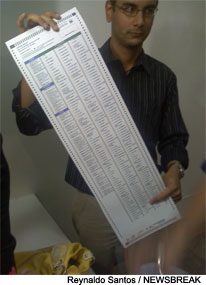SUMMARY
This is AI generated summarization, which may have errors. For context, always refer to the full article.

MANILA, Philippines – A former official of the Commission on Elections (Comelec) told the Supreme Court on Wednesday, May 2, that the poll body erred when it purchased the same automated voting machines it used in the 2010 elections for P1.8-B.
Ex-Comelec commissioner Augusto “Gus” Lagman said the PCOS machines – which will be used for the 2013 midterm elections – have 236 glitches and lack adequate security features.
Lagman, who ceased to be Comelec commissioner after President Benigno Aquino III chose not to re-appoint him in March, said “there is no assurance” that Smartmatic, the provider for the PCOS machine, and its local partner Total Information Management Corp., were able to correct all the glitches in two years time after the 2010 elections.
Lagman said he opposed the signing of a term sheet in April 2011 for the revised extended option to purchase some 82,000 PCOS machines because of the 236 deficiencies.
He added though that he was outvoted by the 6 other Comelec officials – commissioners Roberto Lim, Armando Velasco, Rene Sarmiento, Lucenito Tagle, Elias Yusoph and Comelec chairman Sixto Brillantes Jr.
The option to purchase the PCOS machines was stipulated in the 2009 contract between Comelec and Smartmatic-TIM. But this expired in December 2010.
In April 2011, Smartmatic again put on the table the term sheet. Comelec signed it on April 28, 2011, but the term sheet was cancelled in June of the same year.
Comelec, however, chose to exercise its option to purchase the PCOS machines in March 2012 after Smartmatic extended the option for the third time until the end of the same month.
‘Not inherently impossible’
Lagman said that one of the major glitches is that the compact flash cards or CF cards could be written on more than once. The CF cards or memory cards contain the ballot images.
Justice Lourdes Sereno countered him, however, by saying glitches like these could be fixed through the purchase of new CF cards that are compatible with the system. Sereno then asked Lagman if other glitches could not be fixed through software configuration
“Almost all of them [errors in PCOS] can be solved, but is there enough time to solve those problems?” Lagman answered.
Lagman did admit, however, when pressed further by Sereno, that solutions to the glitches are available. “Is it inherently impossible to remedy the technical problems?” the lady justice asked. Lagman said that it is not.
Lagman also confirmed under the questioning from Justice Presbitero Velasco Jr that he was not present during the demonstration of the PCOS machines on Feb 17, 2012. Smartmatic was supposed to show at that time how they addressed the problems in the PCOS machines.
Lagman said though that his staff was there. He insisted that if public bidding is conducted on the contract, Smartmatic should be disqualified from it.
Cesar Flores, Smartmatic executive, told Rappler on the sidelines of the Court’s oral arguments that Lagman “blatantly misled the public,” saying the 236 glitches are nothing but “cosmetic discrepancies” or minor errors that have already been fixed.
Past shortcomings
Comelec’s alleged failure to equip the PCOS machines with security features in 2010 was brought up during the oral arguments.
Jose Aspiras, one of the lawyers for petitioners Davao City Archbishop Fernando Capalla, former Marawi City Mayor Omar Solitario Ali and former Quezon City Rep. Mary Ann Susano, said that the Comelec did not ensure that the board of election inspectors (BEI) would have a digital signature. “The digital signatures certify that the election returns are coming from right precincts,” he said.
Flores told Rappler that digital signatures were used in the 2010 elections. “The BEI signed the results by using a special button and a special password and no transmission was ever received without a digital signature,” he said.
The source code – a set of instructions readable to programmers – was not also disclosed to the public. Justice Antonio Carpio inquired about this, as the SC ordered Comelec to release the source code in 2010.
“We issued an order, but it was not complied with,” he said.
How about CCOS?
Aspiras also said Comelec should consider other alternatives such as the central count optical scan or CCOS. “Only the BEI will touch the ballots,” he said.
In the CCOS, ballots are fed into an optical mark reader — not by the voters but by the BEI.
The shift to CCOS was also proposed by Zeus Librojo, lawyer for the Social Justice Society, another petitioner who sought the nullification of the P1.8-billion contract between Comelec and Smartmatic-TIM.
Librojo said the use of the CCOS will require fewer Comelec personnel with technical expertise. – Rappler.com
Add a comment
How does this make you feel?
There are no comments yet. Add your comment to start the conversation.